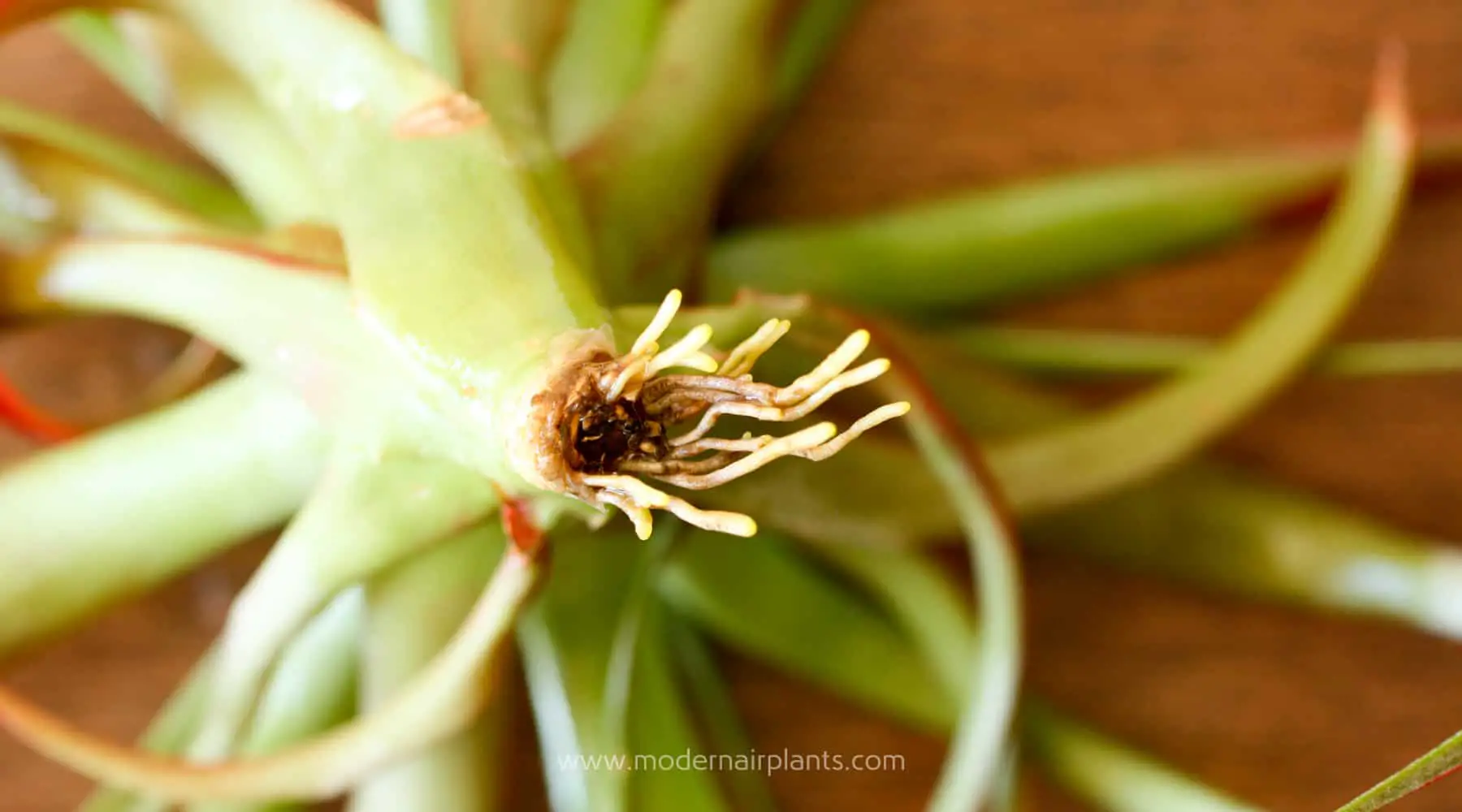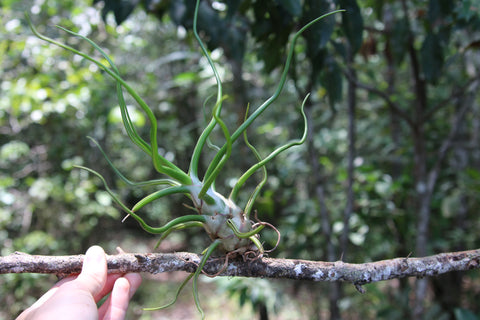Air plants, also known as tillandsias, are epiphytic plants that grow by attaching themselves to other plants, rocks or other surfaces. Despite not being rooted in soil, air plants do grow roots. This often surprises new air plant owners who assume these plants get all their moisture and nutrients from the air. So why do air plants have roots if they don’t use them for water and nutrients?
Why Air Plants Have Roots
In nature air plant roots serve as anchors and grippers. They allow the plant to attach itself securely to trees rocks and other surfaces. This gives the plant stability and protects it from being knocked loose by weather, animals or other disturbances.
While air plants don’t use their roots to absorb water and nutrients from soil, the roots still serve the vital function of keeping the plant firmly fixed in place. Without roots to anchor themselves, air plants would not survive for long in their natural habitat.
Do Air Plants Absorb Water and Nutrients Through Their Roots?
No, air plants do not use their roots to take in water and nutrients. Instead, they absorb moisture and minerals through specialized cells on their leaves called trichomes.
Trichomes are the fine hair-like structures that cover the leaves of many air plant varieties. They have a very high surface area allowing them to rapidly absorb and retain water. Trichomes also absorb nutrients when water flows over the air plant’s leaves.
The roots of an air plant serve only as grippers and have no role in providing the plant with water or nutrients Trimming off the roots will not harm the plant as long as the trichome-covered leaves remain intact
Why Are Air Plants Sold Without Roots?
Most air plants are imported from tropical regions in Central and South America. To comply with agricultural import regulations, air plant growers trim off the roots before shipping the plants internationally.
If the plants arrived with roots intact, they would be classified as live plants and subject to much more stringent permit requirements. Selling bare-root air plants allows growers to ship them economically while still complying with import laws.
Do The Roots Grow Back?
Yes, air plant roots will eventually grow back after being trimmed off. How quickly new roots form depends on the specific variety. In general, more vigorously growing types will regenerate roots faster.
Under ideal conditions, some air plants may begin growing visible roots in as little as 2-3 weeks after trimming. Slower-growing varieties may take 2-3 months to regenerate substantial roots. Providing bright, indirect light and proper watering will encourage faster root growth.
Should You Trim Air Plant Roots?
Trimming air plant roots is purely an aesthetic choice. Removing the roots will not harm the plant, but some people prefer the natural rooting appearance. Others trim the roots for a more streamlined, minimalist look.
If you want to trim air plant roots, use clean, sharp scissors. Cut the roots back as close to the base as possible, being careful not to damage the leaves. Trim just the dead, dried roots while leaving any green roots intact.
Caring For Air Plants With Roots
Caring for air plants with roots is the same as for plants without roots. Here are some tips:
-
Water 1-2 times per week by misting the leaves, soaking upside down in water, or running water over the plant. Drain upside down after soaking.
-
Provide bright, indirect sunlight. A few hours of morning or late afternoon sun is ideal.
-
Use an air plant fertilizer diluted in water once every 2-4 weeks during warm months.
-
Allow the plant to dry fully between waterings to prevent rot.
-
Keep in temperatures between 60-80°F. Avoid excess heat or cold.
-
Air circulation is important to prevent mold and mildew.
-
Trim off any dead, dried leaves as needed.
-
Secure on a mount or in a holder to provide stability if not rooting on a surface.
Do Different Air Plant Species Have Roots?
Nearly all air plant varieties will grow visible roots eventually as part of their natural growth habit. However, the size and extent of the roots can vary by species. Some examples:
-
Xerographica: Forms very thick, woody roots that resemble wood fibers.
-
Tectorum: Grows fine, fuzzy, bright white roots.
-
Bulbosa: Produces thicker roots that emerge from the base in a bulbous cluster.
-
Capitata: Forms numerous thin, wiry roots along its base.
-
Ionantha: Grows minimal roots that are so fine they are nearly invisible.

How to Trim Your Air Plant

So now you have the choice–do you want to keep your air plants au naturale with growing roots or trim them for a clean, defined look? Most enthusiasts that keep their plants inside prefer a cleaner look but those living in warmer, humid climates have the option to keep them outside where they can naturally root to a tree. Just like the plant itself, the roots will continue to grow and will need a trim every so often if that is what you choose to do. You can easily trim your air plants with small kitchen scissors or cuticle scissors–but not too close to the base of the plant, as it can cause damage! While trimming the roots you can also remove dried leaves to clean-up the base and help avoid trapping water and humidity which causes rot.
Because of their soil-free nature, air plants prevail as the superior houseplant–their versatility is unmatched. The possibilities are endless! Now that you know about air plant roots and how they get nutrients, will you trim the air plant roots or let them grow out?
View Our Reviews On RaveCapture Air Plants – To Trim or Not to Trim Tillandsia Roots
How do Air Plants Get Nutrients Without Roots?

Air plants are part of the unique plant family known as epiphytes–Greek word “epi” (meaning ‘upon’) and “python” (meaning ‘plant’). Epiphytes are plants that grow or attach themselves on other plants for support. They are not parasitic plants–meaning plants that acquire some or all of their nutrients from another living plant. Contrary to most plants that get nutrients from their roots in soil, air plants’ root systems are only used to attach and anchor themselves to tree trunks, branches, rocks, etc. Roots are necessary for air plant survival in the wild because they keep air plants off the ground away from animals, tumultuous weather and other threats! Nevertheless, when air plants function as decor, roots are not mandatory and may be removed without compromising the health of the plant. Think of roots like hair! It is still growing all the time but it is technically dead. And people can decide how long or short they want to keep it – just like air plant roots!
Air plants receive nutrients through their leaves from light and moisture in the air. Over time, air plants developed trichomes on their leaves to catch and absorb nutrients. Trichomes–Greek word “trichoma” (meaning ‘hair growth’)–are the white, crystal-like hairs on the leaves that are visible on most air plant species. Another well-known plant with trichomes is marijuana–but don’t eat or smoke your air plants!
Air Plants (Tillandsia) 101 – Care Tips & Fun Facts!
FAQ
Do air plants need to be attached to something?
While air plants don’t need to be attached to anything to survive, they often benefit from being mounted or placed on a surface for support and aesthetic reasons. Their roots primarily serve as anchors, not for absorbing water or nutrients, which they get from the air.
How often should I water air plants?
Air plants generally need to be watered (or soaked) about once a week to ten days. In drier, hotter climates, more frequent watering or a longer soak every 2-3 weeks is recommended. Supplemental misting can also be beneficial between soaks.
What are the disadvantages of air plants?
Air plants require a precise watering schedule for optimal growth and blooming. Overwatering can cause fungus rot and fall apart, while underwatering can cause foliage curling and wrinkling.
Do air plants have roots?
Even though air plants absorb water and nutrients from their trichomes, or sponge-like cells on their leaves, they still grow roots. These roots perform a different function than the roots of most other plants. The sole purpose of these roots is to grab hold of a host plant. Air plants do not harm the host plant, they just need a good anchor.
Do air plants harm a host plant?
These roots perform a different function than the roots of most other plants. The sole purpose of these roots is to grab hold of a host plant. Air plants do not harm the host plant, they just need a good anchor. This may be a tree branch, a rock or even a telephone wire.
How do air plants differ from other plants?
Air plants have a simple structure compared to other plants. They are composed of a stem, leaves, and roots. However, their anatomy has evolved to allow them to absorb water and nutrients from the air, rather than from soil. The stem of an air plant is typically thin and flexible, allowing the plant to bend and twist in different directions.
Are these unique plants air plants?
Chances are, these unique plants are air plants! Air plants are a group within the genus Tillandsia that grow pretty strangely compared to other plants. They lack true roots and simply appear like a random growth of tough, succulent-like leaves.
Do air plants grow on bushes?
Air plants will grow on bushes, rocks, and shrubs. Other epiphytes include orchids (which grow on tropical trees) and many kinds of ferns. 2. Air plants use roots to attach themselves to things (rather than to absorb nutrients). Above: Photograph by John Merkl.
What is the unique anatomy of air plants?
The unique anatomy of air plants serves several functions that allow them to thrive in their environments. Air plants absorb water through their leaves and stems using their trichomes. Trichomes are tiny scales that cover the surface of air plants and are capable of absorbing moisture from the air.
